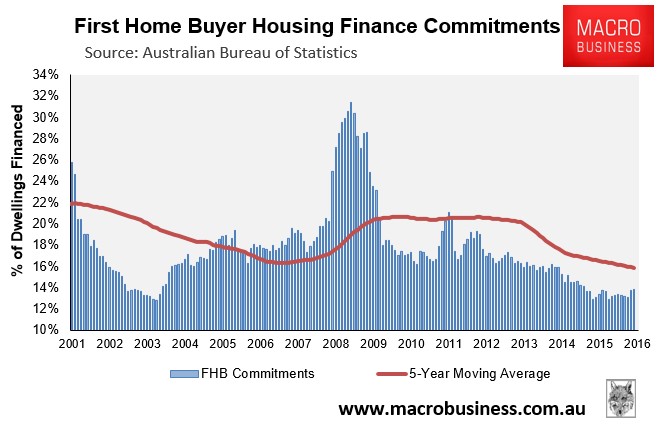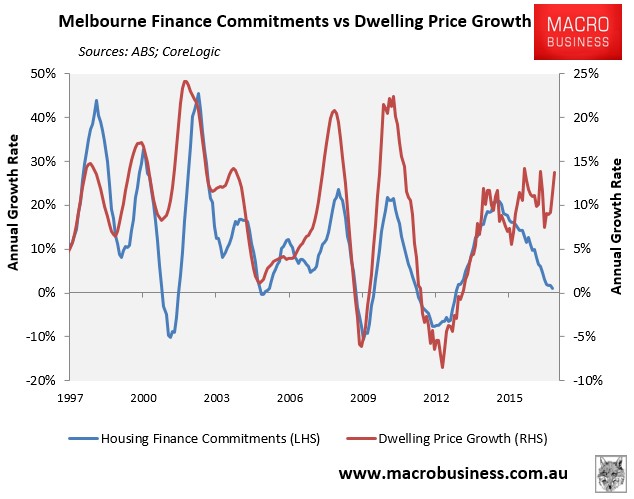Not much news on Donald Trump today so The Age has returned to its other favourite past time, pimping property:

Within the article we find last year’s Flufferfax methodology making a comeback:
Dallas is one of only nine suburbs with a median price under $400,000 — a dilemma for first home buyers, given the average loan size for first-time in the state is $323,900.
Although first home buyer numbers are on the rise in Victoria, they are below average and largely concentrated to the house and land package areas of the city, according to Domain Group chief economist Andrew Wilson.
“I think Melbourne still offers affordable opportunities, but there’s no doubt these areas are a little far flung in relation to the CBD and also underperformers in terms of local infrastructure, although that is improving,” Dr Wilson said.
One of the issues for those at the bottom of the market is that after years of subdued price growth, the budget end has not only caught up, it’s leading the city in terms of where prices are rising fastest, he said.
“We’ve seen a general revival in budget suburbs,” Dr Wilson said. “And we’ll continue to see value suburbs to the outer north and outer south east be the best performers this year, and that means we will get fewer and fewer suburbs with a median under $400,000.”
…Investors are now the main buyer group in Dallas, a suburb where the median house price is $390,500, Mr Celik said.
Agents say it is a similar story in Melton, Melton South and around Frankston.
Adrian Foster, director of Hocking Stuart Frankston, describes the amount of interest from investors wanting to get into Frankston North as incredible.
“It defies belief the amount of calls we’re getting,” Mr Foster said, estimating that about 80 per cent of those calls were from investors.
He said he had seen multiple cases of investors having bought into the suburb a year ago at about $300,000, positively gearing that property for rent at $350 per week, and then easily sold it on 12 months later for $400,000 or more.
No independent data or quotes. Distorted facts. The usual Flufferfax advertorial mix. There is no FHB revival:

And transaction volumes still stink as specufestors price out everyone:

We can’t really even tell if prices are rising thanks to CoreLogic’s meltdown:

But Flufferfax is up and away because:
There have been approaches in the market to at least one party by a fund about buying the Australian arm of Fairfax Media, according to a source, who said the entity was based in Los Angeles and had a presence in Australia.
The plan was understood to involve the group buying the assets once Fairfax’s New Zealand business was divested through a merger deal with NZME, which is now expected to be blocked by the competition watchdog across the Tasman.
Platinum, based in Los Angeles, is known to be eager to snap up media assets globally at opportunistic prices, and it is not the first time it has scanned the Australian market. It came close to buying Arrium’s Moly-Cop mining services operation before it was sold to American Industrial Partners last year for $US1.23 billion.
US-based Fortress Investment Management has also been pinpointed as a possible suitor, given its Australian presence and earlier interest in APN’s regional newspapers when they were for sale last year.
…Institutional investors are known to have been eager for the company that publishes The Age, The Sydney Morning Herald and the Australian Financial Review to spin out its lucrative Domain real estate business, which they believe is grossly undervalued compared to its $7.3bn rival REA, while held within the $1.9bn Fairfax structure.
That’s right, it’s a real estate agent masquerading as a publisher. I would love to see this. Anyone buying will have to overpay for the whole group because spinning off Domain will leave the rump of the business literally worthless.
Still, it might be worth it for a pump and dump of Domain before the next bust ravages it too.

